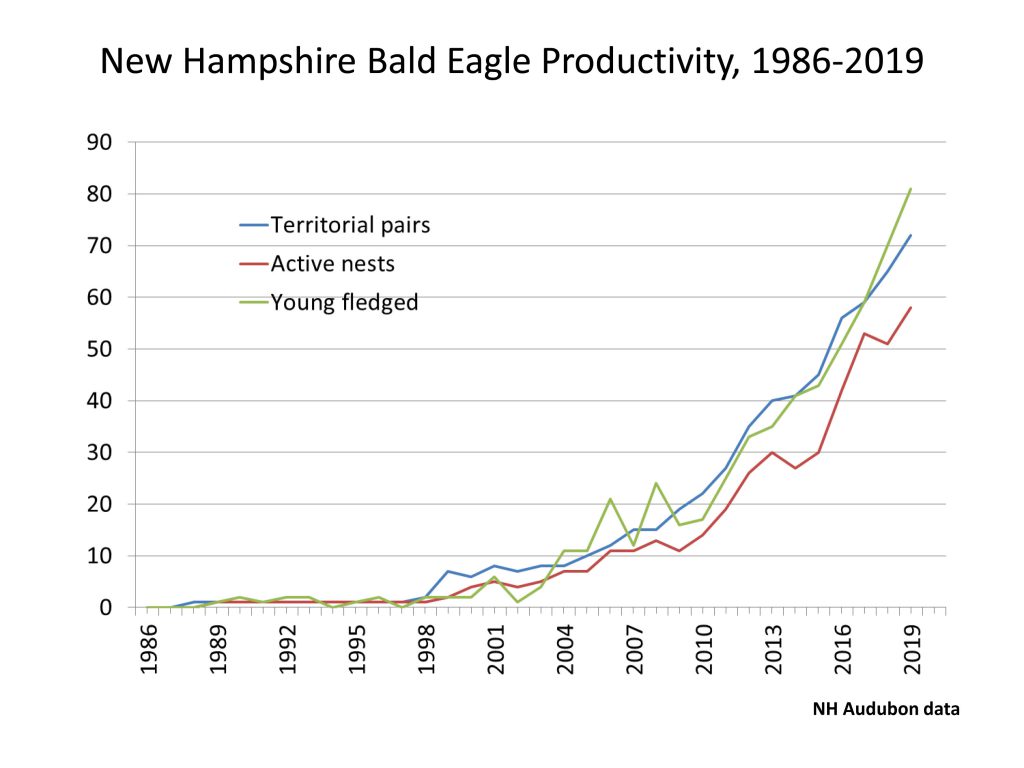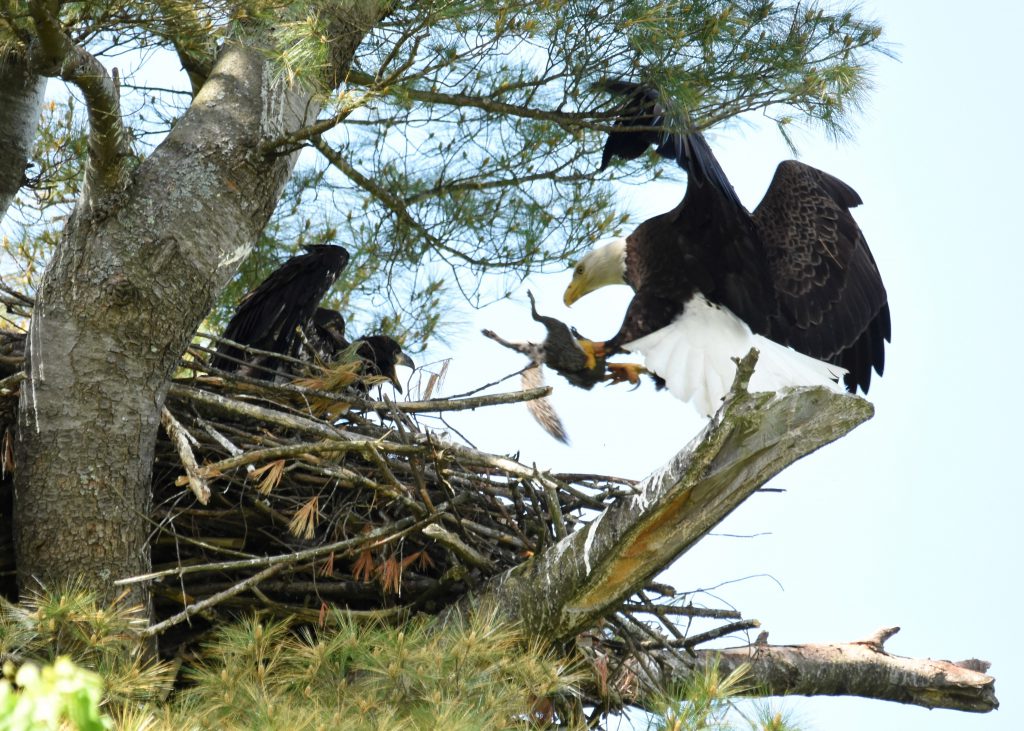
Nesting Eagle Family makes a home on Granite Lake
Hello New Hampshire Eagle-watchers!
New Hampshire Fish & Game removed the Bald Eagle from New Hampshire’s List of Endangered and Threatened Wildlife in March 2017, prompted to do so after seeing several decades of robust eagle recovery data provided by NH Audubon (see attached NH Bald Eagle graph). In the three breeding seasons since State delisting, our eagle population has continued to expand, establishing a number of new breeding territories on previously unoccupied lakes, rivers, and estuaries. This still-growing population, which is doubling every 5-7 years, has stretching the limits of our monitoring resources and is leading us to propose changes in our strategy for tracking this iconic bird. These changes are described further on in this report.

First, here are this season’s numbers:
In 2019, we confirmed 72 TERRITORIAL PAIRS of Bald Eagles in New Hampshire, up 11% compared to 2018. We documented 58 PAIRS INCUBATING, up nearly 14% from 2018. We counted 44 SUCCESSFUL NESTS, 13% more than last year. And we tallied 81 YOUNG FLEDGED, up nearly 16% over the 70 fledglings produced in 2018. Each of the categories listed above reached a new state-record high for the post-DDT (since ~1970) era. The ratio of young fledged per territorial pair – one of our broadest measures of breeding success – hit its highest level in more than a decade at 1.12 young/pair in 2019. A grand total of 578 young Bald Eagles have fledged from NH nests since eagles resumed breeding here 30 years ago. More than a third (36%) of all those NH Bald Eagle fledglings produced since 1989 have fledged in just the past three breeding seasons! Among the 2019 highlights, we identified 10 new breeding territories statewide, including the first successful eagle nest documented within Concord’s city limits in over 100 years. We tallied five successful nests that fledged three young each in 2019, also the most three-chick nests on record for a single year in the state.
NH Audubon staff and volunteers have put considerable effort into ID’ing our resident eagles. Of NH’s 149 known territorial eagles in 2019, we determined the leg-banded status of 52 individuals (35%), while the status of the remaining 97 (65%) was not determined. Of the 52 individuals where we knew the leg-banded status, just more than half (52% or 27 birds) were confirmed to be banded, while just under half (48% or 25 birds) were confirmed unbanded. In 2019, we got positive IDs (full alphanumeric codes) on 18 color-banded individuals seen at NH nests (or seen in a few other non-nesting situations) and these birds ranged in age from 7-15 years old, plus one 1-yr old. Of these 18 eagles, 50% had burnt orange or gold bands from MA, 22% had red bands from ME, 11% had black bands from NH, and 11% had black bands from CT. And unexpectedly, there was a 1-yr old with a purple band from VA that died in a Lebanon, NH landfill.

All of our volunteer observers and photographers contribute so much to our monitoring efforts each year, and they deserve much of the credit for gathering data on our nesting eagles and for providing so many wonderful images that help us with our educational outreach! For your enjoyment, out of hundreds of images we received in 2019, I’ve selected six images by six different individuals to share, as follows: squirrel for dinner in Canterbury by Debbie LaValley; nest-building sub-adult in Concord by Diane Seavey; two fledglings in Hebron by Jack Dorsey; eagle pair in Hopkinton by Donna Ellis; in a new nest tree in Moultonboro by Libby Corbin; and wearing satellite transmitter in Pittsburg by Kathy Gagnon Bedard. Thanks to all of you for your interest and partnership, and for volunteering your time!
In closing, I want to return briefly to the topic of NH Audubon’s eagle monitoring strategy going forward. With the state’s eagle population continuing to grow, and after much discussion with partners at NH Fish & Game, NH Audubon has agreed to adopt anew monitoring protocol that divides the state into five monitoring zones (North Country, Connecticut Valley, Lakes, Merrimack Valley, and Coastal). In our work for NH Fish & Game, we will actively monitor breeding sites in one zone per year for the next five breeding seasons, which means we will rotate through the entire state once every five years. We will also document new breeding sites as they are reported from anywhere in the state, and add them to the appropriate zone for future monitoring. We recognize that for a growing population this change in monitoring strategy will result in estimates that lag behind what is actually happening with the NH eagle population. But given continued increases in the number of territories, we believe this strategy will allow us to detect any significant population changes in a cost effective way.
Even with this new plan, we’ll still need to raise additional funds beyond the $6K in State Wildlife Grant (SWG) funds we receive annually from NH Fish & Game for eagle monitoring and management. We are grateful for individual donors who supported our work in the 2019 season, in particularly for support from Ann Preston and JoAnn O’Shaughnessy. As always, volunteers remain critical to our future monitoring efforts, and I look forward to working with everyone as we streamline eagle monitoring.
You can help us sustain our Bald Eagle monitoring efforts by donating at:
Thanks for your support!
Chris Martin
Senior Biologist, NH Audubon
cmartin@nhaudubon.org
